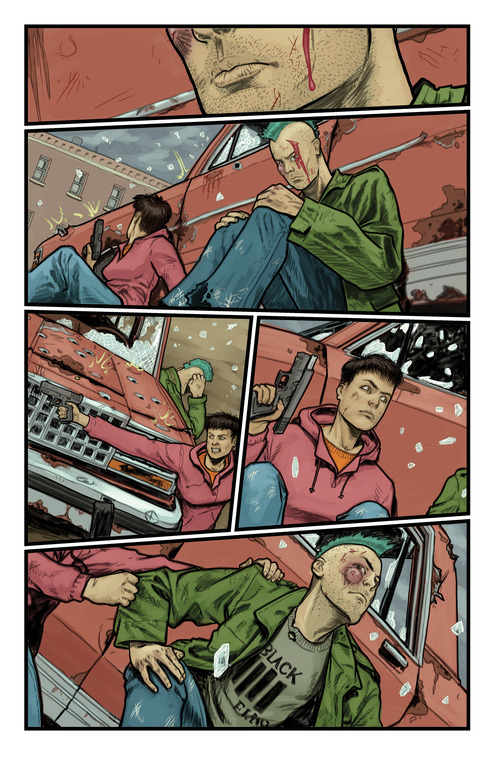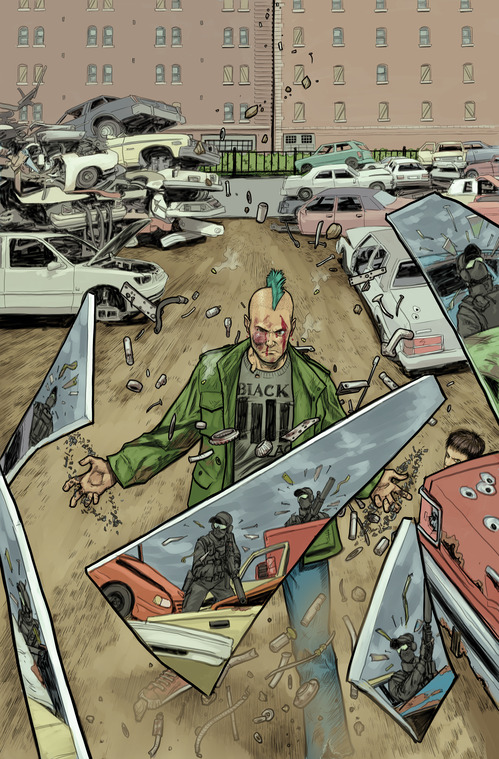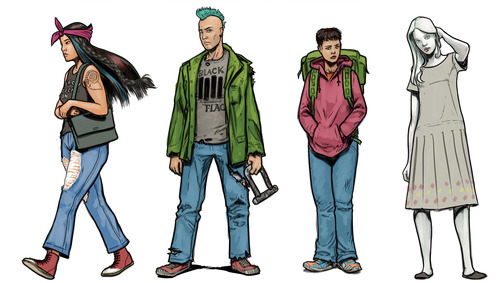Exclusive: Caitlin Kittredge, Steven Sanders Blow Minds on New Image Sci-Fi Comic, Throwaways
Announced today at Image Expo, Throwaways marks a new path for fantasy novelist and Coffin Hill scribe Caitlin Kittredge. Illustrated by Steve Sanders, the new ongoing follows the trials of Dean Logan—the offspring of a psychic government operative—as he escapes his parents’ former handlers of the MK-ULTRA, a real 1950s CIA program designed to to produce telepathic soldiers. Dean soon joins forces with Abby Palmer, a former soldier trained by the same program. The pair unite to devastate the callous bureaucracy that not only created but is attempting to end their lives.
Straying from the horror-tinged escapism of series like Nocturne City and The Iron Codex, Kittredge and Sanders are diving headfirst into black-ops chaos rooted firmly in stranger-than-fiction history. As she explains below, Kittredge has been devouring history books since high school. For the creators, this project culminates from a series of intellectual obsessions into a thrilling assault of action and disarming introspection, especially during a year when police brutality has shed a harsher spotlight on government accountability. To explore this new project, Paste spoke with Kittredge about changing aesthetic gears, history book deep diving and why Black Flag shirts will never stop kicking ass.
Paste: We have the psychic runaway progeny of a spy teaming up with a renegade agent who’s set on destroying the black ops organization that made her. I tend to associate you with horror and fantasy from you work on Coffin Hill and your novels. What attracted you to a realpolitik sci-fi thriller?
Caitlin Kittredge: I have wanted to do a story like this for a really long time, and this is the first opportunity that I’ve had to explore it. I think it was fate that it took me so long to do. Like you said, it’s a real-world story with a sci-fi bent, more of a thriller than my fantasy and horror stuff. This really couldn’t have worked any other way except as a comic, and I think specifically an Image comic, because it’s just so perfect. It fits so well with what they do and the standards of the project. This is an idea I’ve had for a really long time and that I’ve wanted to do forever, and it’s finally coming to fruition. It’s very exciting for me.
Paste: Police brutality—with the Michael Wood’s tweets, Ferguson and Baltimore as recent examples— is beyond a significant issue at the moment, and has led to so much introspection on the relationship between citizen and law enforcement. I know fictional concepts can sometimes incubate for years before they see the printed page, but how much of this year’s news cycle influenced the plot and themes here?
Kittredge: You’re not wrong in that I am interested in things like that—I have been interested really since before this year in different events that have unfolded in the past, even 15 or 20 years. I think with the stuff that’s happened this year, there’s never been a better time to tell this story. I think that it’s more timely now than ever.

Throwaways Interior Art by Steve Sanders
But I’m a big history buff. I read a lot of nonfiction about history, especially Cold War history and I was always really fascinated by the history that our country and the Nazis and the Soviet Union have with human experimentation. The ethics of it, the legality of it. I was in high school reading about the MKULTRA and this dark, painful history that the government and the medical profession have in experimenting on unwitting human subjects, and the whole idea blossomed from there. So it’s definitely approached in a way to look into some real-world issues in that area. I think with everything that’s been happening this year, things reaching critical mass more and more, with people being fed up with secrecy and demanding transparency, I don’t think there’s ever been a better time to tell it. I’m just thrilled that I got to be the one to do it at this particular moment in time.
There’s definitely [overlapping] themes here: breaking the cycle of secrecy, family histories of violence, societal histories of violence. There’s a lot in the first story arc that deals with that. I’m looking at a macro and microcosm.
Paste: You touched on this, but how much military and Cold War history did you research? What did you discover that was the most intriguing or disturbing?
Kittredge: [Laughs] I’ve probably read hundreds of books at this point in various aspects of history, from the end of World War I up through now. I’m just an omnivorous reader and I tend to get into this one thing. I was reading about all of these medical and psychological experimental programs that the government and various intelligence agencies had run throughout the 20th century. Any book you can read on that, there’s some really horrifying and fascinating stuff that goes on there. I’ve also done a lot of reading on Western intelligence agents who have become double agents either with China or the Soviet Union. Like Robert Hanssen, Kim Philby, all of those guys. Aldrich Ames—the famous double agent who worked with the CIA. The duality of living that life has really fascinated me, so I pulled a lot from that for the personalities of the central protagonists in Throwaways. There are a million great books out there if you just go to Google. There’s a lot to pull apart. A lot of crazy unbelievable stuff that’s all completely true. I get into little obsessions and I read everything I can find on one thing, and then I move onto another.
Paste: What’s your current fascination right now?
Kittredge: I’m actually not reading anything about the Cold War in the 20th Century. I’ve been on this kick reading about the beginning of forensic science: autopsies, fingerprinting, psychological profiling. I’ve been reading a lot of books about forensic anthropology. I’m reading a great book now about a serial killer in 1890s France named Joseph Vacher, who basically terrorized the south of France for three years before they caught him, and it was the first trial where modern psychology and modern autopsy techniques were used to convict someone. It’s a big landmark. That’s become my latest obsession.

Throwaways Interior Art by Steve Sanders
-

-

-

-

-

-

-

-

-

-

-

-

-

-

-

-

-

-

-

-

-

-

-

-

-

-

-

-

-

-

-

-

-

-

-

-

-

-

-

-










































